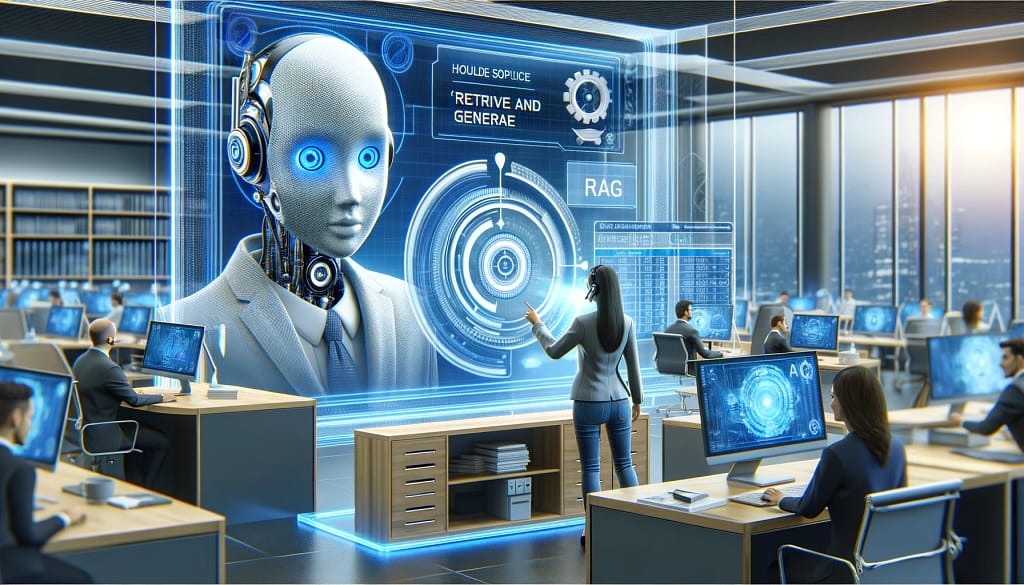Build a RAG Chatbot for Customer Service: Unlock Intelligent Chats and transform your customer interactions with cutting-edge technology. In today’s fast-paced digital landscape, exceptional customer service is essential for staying ahead. By following our guide, you’ll learn how to create a powerful RAG (Retrieval-Augmented Generation) chatbot that enhances responsiveness and efficiency. No coding skills are required—just follow our straightforward steps to unlock the potential of intelligent chat technology and elevate your customer service experience to new heights.
Key Takeaways
- Building a RAG (Retrieve and Generate) chatbot for customer service can significantly enhance the efficiency and responsiveness of your support team by categorizing inquiries based on urgency and complexity.
- Start by understanding the unique needs of your customer service process to design a RAG chatbot that effectively sorts inquiries, ensuring that high-priority issues are addressed promptly.
- Planning your RAG chatbot involves outlining the conversation flow, deciding on the criteria for categorization, and integrating it with your existing customer service tools for a seamless experience.
- The actual building phase requires a focus on creating intuitive conversational AI that can accurately interpret and classify customer queries into the red, amber, or green categories.
- Optimizing your chatbot for conversational AI is crucial; this means regularly updating its knowledge base and improving its natural language processing abilities to better understand and respond to customer needs.
- Implementing your chatbot successfully involves thorough testing, training your team on how to use it, and continuously gathering feedback from users to make iterative improvements.
Understanding RAG Chatbots
Basics of RAG
Retriever-Generator (RAG) architecture introduces a dynamic approach to chatbot development. It merges the retrieval of relevant documents with the generation of responses. This method ensures that the chatbot can pull information from a variety of sources before crafting an answer. Machine learning and natural language processing play crucial roles here. They enable the chatbot to understand queries and retrieve accurate data.
RAG’s unique structure allows it to learn from interactions. This results in improved performance over time.
Benefits of build a RAG Chatbot for Customer Service
Build a RAG chatbot for customer service to significantly enhance response accuracy and customer satisfaction. By analyzing vast amounts of data, RAG (Retrieval-Augmented Generation) chatbots provide precise answers to complex queries. This capability surpasses standard chatbots, which might struggle with intricate questions. Build a RAG Chatbot for Customer Service leverage advanced natural language processing techniques to understand the context and intent behind customer inquiries, enabling them to deliver highly relevant and accurate responses.
Moreover, build a RAG chatbot for customer service to allow businesses to provide 24/7 support, as these systems can operate around the clock without the need for human intervention. This continuous availability ensures that customers can get the assistance they need, whenever they need it. By investing in a RAG chatbot, companies can streamline their customer service operations, reduce response times, and ultimately boost overall customer satisfaction.
RAG Chatbots vs Traditional Chatbots
RAG chatbots excel in adapting to new data, unlike traditional models that require manual updates. Their superior natural language understanding allows for more nuanced conversations with users.
The key difference lies in personalization and context handling. By taking into account the conversation’s history, RAG models provide customized responses. This contrasts with traditional chatbots, which often miss nuances in long exchanges.

Planning Your RAG Chatbot
Define Objectives
Setting clear objectives is crucial when building a RAG chatbot for customer service. These goals might include reducing response times or enhancing the rate at which queries are resolved. Such targets not only steer the development and training of your chatbot but also ensure it aligns with broader customer service aims. It’s essential to map out these objectives early on, as they will influence many aspects of the chatbot’s design and functionality.
Objectives should mirror your commitment to improving customer experience. They guide every step, from initial design to final implementation, ensuring the chatbot serves its intended purpose effectively.
Identify Customer Needs
Identifying customer needs is a crucial step in building a RAG chatbot for customer service. Understanding what your customers frequently ask about or need help with is essential for creating an effective chatbot. This insight can come from surveying customers or analyzing logs from past interactions. Such data is invaluable in shaping the chatbot’s knowledge base, making it more adept at handling common queries. By identifying customer needs accurately, you can ensure that your RAG chatbot is equipped with the necessary information to provide relevant and helpful responses.
Moreover, identifying customer needs helps you prioritize the development of your RAG chatbot. By focusing on the most common and critical customer inquiries, you can ensure that your chatbot is capable of handling a significant portion of customer interactions from the start. As you continue to identify and address additional customer needs, you can iteratively expand your RAG chatbot’s capabilities, making it an increasingly valuable asset to your customer service operations.
Choose the Right Tools
The backbone of any effective RAG chatbot lies in its technology stack. To build a RAG chatbot for customer service, opting for robust machine learning frameworks and natural language processing libraries is key. Considerations such as scalability, ongoing support, and access to community resources should influence your choice.
Exploring existing platforms that specialize in RAG chatbots can be beneficial too. These often come with features that simplify integration and allow for greater customization, making them a valuable asset for businesses looking to deploy sophisticated chatbots without starting from scratch.
Essential Steps to Build a Rag Chatbot for Customer Service
Data Collection
To build a RAG Chatbot for Customer Service, high-quality, diverse datasets are crucial. These datasets train the model to understand and respond accurately. Gathering relevant documents, FAQs, and records of customer interactions is essential. This data forms the foundation of the chatbot’s knowledge base.
Continuous data collection is vital for ongoing improvement. It ensures the chatbot remains up-to-date with new information and customer queries.
Training Models
The training process involves feeding the collected data into the RAG model. This step teaches it to generate accurate responses based on previous interactions and information. Achieving a balance between retrieval (finding the right information) and generation (creating appropriate responses) is key for optimal performance.
Iterative training and validation play a critical role in refining the chatbot’s accuracy. They ensure that with each cycle, the chatbot becomes more adept at understanding and responding to customer queries.
Integration and Testing to Build a RAG Chatbot for Customer Service
Integration and testing are critical steps in build a RAG chatbot for customer service. Integrating the RAG chatbot into existing customer service platforms requires careful planning. The transition should be seamless to not disrupt current operations. Thorough testing in simulated environments helps ensure reliability before going live. This integration and testing process is essential to guarantee that your RAG chatbot functions smoothly and efficiently within your existing customer service infrastructure.
Beta testing with real users is invaluable when you build a RAG chatbot for customer service. It provides feedback on how well the chatbot performs in real-world scenarios. By conducting beta tests, you can gather insights into how users interact with your RAG chatbot and identify areas for improvement. This feedback allows you to make adjustments to enhance the chatbot’s effectiveness further, ensuring that it meets the needs and expectations of your customers.

Optimizing for Conversational AI
Enhancing Natural Language Understanding
To make chatbots more effective, improving their language comprehension is crucial. This involves training them on a wide range of linguistic variations and dialects. Advanced NLP (Natural Language Processing) models play a key role here. They help bots grasp complex queries and the subtleties of human language.
Contextual awareness is another pillar for enhancing understanding. It ensures that responses are not just accurate but also relevant to the ongoing conversation. This requires ongoing training with real-life dialogues and scenarios.
Personalizing Responses
RAG chatbots excel in tailoring conversations by analyzing customer data and previous interactions. This capability allows them to offer responses that feel more individualized and engaging. However, developers must navigate the fine line between personalization and privacy concerns carefully.
Personalized responses significantly boost customer satisfaction. They make users feel understood and valued, fostering a stronger connection with the brand.
Continuous Learning
For a chatbot to remain useful, it must evolve with its user base and the ever-changing world. Incorporating new information and customer feedback into its knowledge base is vital for this continuous growth. Automating the learning process helps keep the bot up-to-date without manual intervention.
Human oversight cannot be overlooked though. It ensures that updates align with user expectations and company values, maintaining a balance between automated learning and human intuition.
Implementing Your Chatbot
Deployment Strategies
Deploying a RAG chatbot requires careful planning. Different customer service channels have unique needs. It’s vital to tailor the bot’s deployment accordingly. A gradual rollout is key. It allows for monitoring and adjusting before full implementation. This approach minimizes potential disruptions in customer service.
Managing customer expectations is crucial during this transition. Clear communication about the chatbot’s capabilities and limitations ensures users know what to expect. This transparency helps in building trust with the technology.
User Feedback Loop
Collecting user feedback is essential for assessing a chatbot’s performance. It provides insights into how well the bot meets customer needs. There are several methods to gather this feedback, such as surveys and direct feedback options within the chat interface.
Incorporating this feedback into ongoing training improves the chatbot continuously. It also helps in identifying new customer needs and expectations, ensuring the chatbot evolves with its users.
Scaling and Maintenance
As demand grows, scaling the chatbot solution becomes necessary to handle more queries without compromising quality. Regular maintenance is equally important. It addresses technical issues and updates the knowledge base to keep information current.
A dedicated team should oversee these tasks. They ensure the chatbot’s performance remains high and it adapts over time to changing needs.

The Final Word: How to Build a RAG Chatbot for Customer Service Excellence
Building and implementing a RAG chatbot for customer service isn’t just about staying on the cutting edge; it’s about genuinely enhancing your customer’s experience. You’ve walked through understanding what RAG chatbots are, planning, building, optimizing for conversational AI, and finally, implementing your chatbot. Each step is crucial in ensuring that your service not only meets but exceeds customer expectations. This journey equips you with the knowledge to create a tool that’s not just efficient but also empathetic and responsive to your users’ needs.
Now, take this knowledge, apply it, and watch as your customer service transforms. Remember, the goal is to make every interaction with your customers as seamless and helpful as possible. If you’re ready to elevate your customer service game, start building your RAG chatbot today. Your customers will thank you for it.
Frequently Asked Questions
What is a RAG Chatbot?
Build a RAG chatbot for customer service, leveraging Retrieval-Augmented Generation for conversations, utilizes a blend of retrieved information and generative AI to provide accurate and contextually relevant responses in customer service.
How do I start planning my RAG Chatbot?
Begin by defining your customer service goals, understanding your audience’s needs, and mapping out the conversation flows. This initial planning ensures your chatbot provides valuable support.
What are the steps to build a RAG Chatbot for customer service?
Building a RAG chatbot involves designing conversation flows, integrating with existing databases or knowledge bases for retrieval, programming generative AI models for dynamic response generation, and testing extensively before deployment.
How can I optimize my chatbot for Conversational AI?
Optimize by refining natural language processing capabilities, ensuring it understands various user intents, and continuously updating its knowledge base to improve accuracy and relevance of responses.
What should I consider when implementing my chatbot?
Ensure seamless integration with your customer service platform, prioritize user privacy and data security, and establish clear metrics for evaluating performance post-implementation.
Can a RAG Chatbot handle multiple languages?
Yes, with proper configuration and training on multilingual datasets, a RAG chatbot can support conversations in multiple languages effectively.
How does a RAG Chatbot improve customer service?
A RAG Chatbot totally levels up customer service, you know? It’s like having a super smart buddy ready to help 24/7, without any breaks or downtime. Imagine you’ve got a question or hit a snag with something you bought – boom, this chatbot is there in a flash to sort things out. It’s all about giving quick, accurate answers, making customers feel heard and valued. Plus, it cuts down on wait times and frees up human staff to tackle more complex issues. So, yeah, it’s a game-changer for keeping customers happy and coming back for more.
What is the cost to build a RAG chatbot for customer service?
The cost of building a RAG chatbot can vary widely depending on factors like complexity, customization, and integration needs.






